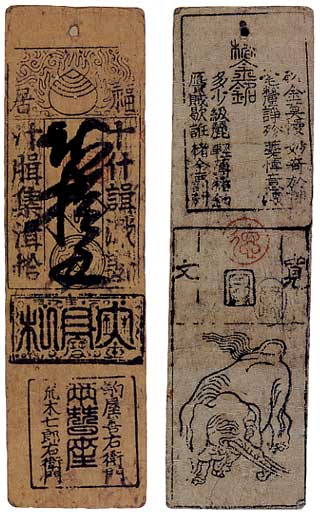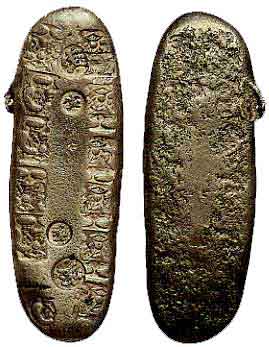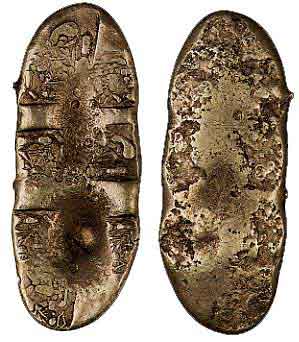Japan:Money
From Marteau
| 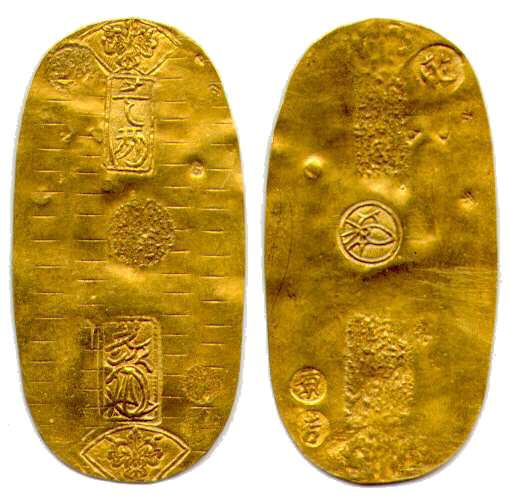
Japan 1710-1714 (Hoei Era) Gold Koban or Ryo |
The Closed Country
Japan practiced a policy of national seclusion – the "closed country" or "sakoku" policy – aiming at autarky in economical terms, yet it developed a trade deficit resulting in the 1690s in a severe shortage of money. Japan's Edo or Tokugawa period beginning in the early years of the 17th century (see Japan's dynasties and rulers) became a period of stability and growth, yet the developing nation failed to turn the advatageous situation into one of wealth creating more wealth – paradoxes sharpened by the dangerous monetary decisions of the 1690s and early 1700s. Compared with the parallel history of England's monetary decisons following the 1680s one could read the history of money in Japan as one of all the fatal decisions those responsible in London's could not even dream of.
Selling Silver for Silk – International Trade Relations
Japan's economy was at the beginning of the 17th century – after a century of internal wars – theoretically independent. The strife between the feudal clans (daimyo) had led to a concentration of power. Oda Nobunaga, 1534-1582, the first of Japan's three unifiers, had effectively welcomed the Portuguese who had landed on Tanegashima island in 1543. Their technological support – fire arms – was helpful and the Jesuit mission they brought seemed especially convenient to counterbalance the power of the militant Buddhist cloisters. Toyotomi Hideyoshi, 1537-1598, his successor, acted undecided between toleration and a total ban of the Christian mission. Tokugawa Ieyasu, 1543-1616, the final unifier of Japan eventually opted for the seclusion of the country and a ban of Christianity. Supported by the Portuguese, the Spanish and the Dutch the new faith had proven to be of no real service on Japan's way to a centrally governed state. In 1612 the shogun's retainers and residents of Tokugawa lands were ordered to foreswear Christianity, in 1616 all foreign trade was restricted on Nagasaki and Hirado, an island northwest of Kyushu. The Kyushu daimyo had been the most prominent supporter of the new faith just before. 1622 saw the execution of 120 missionaries and converts, 1624 the expulsion of the Spanish, 1629 a wave of executions with thousands of Christian victims - an estimated 500,000 Japanese had embraced the new religion over the last decades. The edicts of 1633 and 1635 prohibited all contact between Japanese and foreigners: Ships and Japanese subjects were forbidden to leave Japan for a foreign country without a license; all Japanese living abroad were to be put to death if they tried to return to Japan (except those who had resided abroad for less than five years and had been unavoidably detained). The Nagasaki commissioners were to investigate all those suspected of being Christians, and a reward was offered to any informer who revealed the location of "Bateren", foreign priests. Foreign ships arriving, were to be guarded while a report was sent to Edo. A strict search was to be made for bateren on all ships entering Japan. The Portuguese were restricted to Deshima, an artificial island especially created for that purpose in Nagasaki's harbor. The Shimabara Rebellion of 1637-38, in which discontented Christian samurai and peasants rebelled against the bakufu (the shogunate administration), was ended by Edo's government through the help of the Dutch whose ships bombarded the rebel stronghold. Soon thereafter, all "southern barbarians" – the term refering to the Portuguese and Spanish – were permanently expelled, members of the Portuguese diplomatic mission were executed, all subjects were ordered to register at a Buddhist or Shinto temple, and the Dutch and Chinese were restricted, respectively, to Deshima and to a special quarter in Nagasaki. Besides small trade of some outer daimyo with Korea and the Ryukyu Islands, to the southwest of Japan's main islands, by 1641 foreign contacts were limited to Nagasaki.
The political turmoil of the late 16th and early 17th centuries had paved the way to the Tokugawa or Edo period – the period in which Edo, today Tokyo, became the political centre of the nation. Power was from now onwards to lie in the hands of the shogun; the emperor played a ceremonial rather than a political role. The political stability the new regime dictated, allowed growth. Those who profited from the situation found, however, few incentives for investing their wealth in anything more profitable than their representation. As far as the trade balance is concerned the wealth created in Japan came to be spent on luxury goods satisfying the rich upper class. Silk from China and ginseng from Korea became the most important imported goods. An estimated 1.1 million kan (4,125 tons) of Keicho cho-gin – approximately three-quarters of the silver coinage and silver produced in Japan – left the island in this exchange over the hundred years from 1614 to 1714. A ban on exporting gold that had been implemented to curb the outflow, was lifted in 1664, the sell-out of gold and silver became legal and accelerated in the last decades of the 17th century – till the monetary decisions of the years 1695-1714 served to make goods produced outside Japan too expensive to be paid with money that freely any longer.
Trade Relations with Europe
Trade relations with Europe were everything but marginal. They had begun with the arrival the Portuguese in 1543. Dutch explorers had reached Usuki Bay on the southern Japanese island of Kyushu in 1600. Their original expedition had started with 5 ships from Rotterdam on June 27th 1598 of which only one had reached Japan – the Liefde with 24 men, 23 Dutch, and their English captain. Europe's nations contested each other over influence on Japan's growing regime. The Dutch eventually won and gained the monopoly on Japan's trade with Europe. The privilege was otherwise an ordeal: the permanent settlement to be reached over a bridge included a director of the Dutch East India company and about ten employees. No foreign women were allowed on Deshima island. (The regulation was first violated in 1817, Japan's authorities could, however, enforce their laws three months later). Dutch ships came twice a year – time which had to be passed in isolation. But the base paid: In 1662 the Dutch trading houses withdrew from Taiwan. The Taiwan-Nagasaki import route on which white raw silk, the finest type of Chinese raw silk, used to reach Japan, lost its importance. Nagasaki became the central harbour of a trade now focussing on Korea; and the Tsushima domain became the mediator sustaining the new trade connection. The connection provided Japan with import goods right into the 1690s. Chung Sungil ["The Volume of Early Modern Korea-Japan Trade: A Comparison with the Japan-Holland Trade" Acta Koreana vol 7-1, 2004] compared trade volumes passing between Korea and Japan in Pusan and between Japan and the Dutch in Nagasaki and concluded that trade with the Dutch did not outweigh the Korean-Japanese trade before the 1690s. The situation changed after 1695 and Chung Sungil's investigation implies that the main reason for the change had little to do with official ceilings set by the Tokugawa shogunate. The Tsushima daimyo was effectively able to circumvent any restrictions and send false reports to the bakufu whilst the Japan-Dutch trade connection could be tightly monitored by the central government. The primary reasons for the drop of the trade with Korea seems to have been the devaluation of Japan's silver money in 1690s.
Later efforts to bring back the old currency and to thus solve the problems of Korean-Japanese trade relations, failed. When re-introduced for trade abroad in 1710 (and in 1714 for trade inside Japan) the better money was no longer affordable to those who had first lost their wealth when acquiring the worthless money of the 1690s and early 1700s. Goods from abroad remained expensive.
The Dutch, more interested to buy than to sell – silk and porcelain, goods to be sold on Europe's markets with good profit rates – could take the otherwise catastrophic situation as an advantage. They could offer what Japan needed: money for goods to be sold on other markets.
Monetary Politics
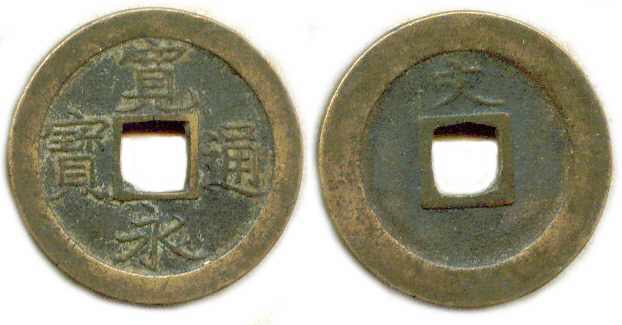
Japanese mon, the basic copper coin, as minted between 1668 and 1700
The Edo or Tokugawa period had begun around 1600 with the settlement of the feudal conflicts. The clans had lost power to the central shogunate government. Decisions to create a central currency stood at the beginning of the era. The new money was to have gold, silver and copper units – all exchangeable at fixed rates. The Oban and the Koban gold coins were oblong plates, the smaller Ichibukin little rectangular pieces of minted gold. Silver was hardly minted in the European sense of the word. It was traded in lumps and weighed. The central unit for silver, the momme, was (and still is) a mere unit of weight matching 3.75 g. The lowest unit, the copper mon was influenced by the design of Chinese coins, the only object in the ensemble resembling a conventional coin. The rates between gold and silver were fixed, yet market reates fluctuated. The pattern did not change between 1600 and 1700:
| Gold | |||
| 1 Oban | = | 7.5* Ryo | |
| 1 Ryo / Koban | = | 4 Bu | |
| = | 4 Kan | ||
| = | 70* Momme | ||
| 1 Bu | = | 4 Shu | |
| 1 Shu | |||
| Silver | |||
| 1 Kamme | = | 1000 Momme | |
| 1 Momme [3.75 g] | = | 10 Fun | |
| 1 Fun | = | 10 Rin | |
| 1 Rin | |||
| Copper | |||
| 1 Kan [3.75 kg] | = | 1000 Mon | |
| 1 Mon |
*market rates
Wages for ordinary people were paid mostly in copper and silver coins. Wages for the Samurai class, which accounted for 10% of the total population, were paid in amounts of rice. The Tokugawa shogun granted the Samurai a fief, the stipend was measured by the volume of rice the region could be expected to produce. Three times the year the Samurai sold the rice collected as a land tax to traders – the Samurai were better served with money they could spend on goods – part of the problem Japan's economy faced.
Japan's trade developed a sophisticated system of cashless payments on Osaka's market – the central market for goods produced in Japan. Transactions between merchants were settled in silver. In order to reduce the transaction costs the exchange of metal would have produced, a check system developed with checks issued on the basis of current account deposits at money changers, the "ryogae-sho". The development which led back into the 1660s supported the commercial transaction with its smooth fund settlement. Between 1716 and 1736 about 650 ryogae-shos settled the checks issued by about 6000 merchants every day. The system was as efficient as the Giro-system used in European countries. Access to it was, however, limited to the leading merchants and it was never used to pay wages. It remained the system of Osaka's wholesale market. Business in cities like Edo and Kyoto did hardly go beyond retail transactions.
Three characteristics distinguished Osaka's check system: Central institutions, such as the centralized check clearing institution and a centralized fund settlement institution, did not exist. The ryogae-sho had strong ties among each other, together they formed a strict hierarchy with few but powerful money changers called juunin-ryogae at the top. The juunin-ryogae created a de facto central fund settlement by establishing correspondent deposit accounts used exclusively for mutual settlements. All the checks requested by the subsidiary ryogae-sho were settled within this system. In this sense, the large fund settlement system centring on juunin ryougae can be interpreted as a hybrid of a check clearing and fund settlement system. Thirdly, the juunin ryogae ensured a final settlement by allowing overdrafts of accounts. These were usually settled by gold and silver coins based on the net liability amount gained through balancing the debit and credit every half a month or month. The complex system remained intact until the institution of a modern banking system in the 19th century.
Trade inside Japan was furthermore facilitated by an exchange of paper money gaining importance on the level of the clan territories issuing the respective notes.
Paper Money of the Clans
Paper money promising a given value of gold, silver or copper, was first issued by merchants of the Uji-, Matsuzaka-, Isawa-, Yamato-shimoichi-, and Settsuhirano-go-regions: the Yamada Hagaki notes. The shogunate's metal coinage and rivalling clan notes issued by the local feudal lords, left, however, no room for a further development of Yamada Hagaki notes. An autonomous administrative body of the Yamada region, the Sanpokai-gosho, was eventually the only authority issuing Yamada Hagaki notes – under permission of the shogunate which thus stabilised the regional power short of money. In the early 18th century, old notes of this production were exchanged for new ones at intervals of seven years to limit the amounts in circulation and the risk of forgeries.
|
|
Hansatsu as issued by the Fukui clan in Echizen from 1661 to 1673: A silver 10-momme note from 1666. The denomination is noted in ink and traced on both sides by rows of characters of different shapes and meaning, all pronounced however, identically as "ten", the note's denomination. (Image: curtesy of the Bank of Japan's web page) |
Paper money issued by the feudal clans – the "han", hence the term "hansatsu" – differed from Yamada Hagaki in that it effectively demanded respect as legal tender substituting all gold, silver and copper transactions within the borders of the region issuing the notes. Local authorities supported their paper monies by prohibiting the circulation of species money and by imposing charges on any exchange of paper and metal money within their reach. Hansatsu notes were almost always authorized by the shogunate – by the same shogunate which strove for a unified metal based currency and for supremacy over the feudal lords. Hansatsu issued by a region could, so the laws, not claim any value outside their region. The hansatsu currencies financed and stabilised regional power on the regional level – a stabilisation the shogunate could approve of especially if it became the superior power granting the rights to issue such money. The Fukuyama and the Bingo regions played a leading role in the introduction of hansatsu in the 1630s, the second half of the 17th century saw paper money winning trust throughout the country. The shortage of metal and the massive debasement of the coin implemented by the shogunate in the 1690s did everything but increase the trust in money the central authorities offered. In 1707 the shogunate finally banned all paper money – allegedly a measure designed to curb abuse stemming from the unlimited circulation of hansatsu outside their respective homelands. The measure played, however, its much more important role in the second step of the debasement of Japan's metal money. With the ban of 1707 more than 50 feudal clans had to change hansatsu they had issued into specie the shogunate issued. Those who changed paper money into gold and silver lost about half of the money they had invested to acquire the paper notes – to the advantage ot the central government issuing the new metal money it could otherwise hardly have brought into circulation.
The Unified Currency – Metal Money
The problem of metal money was its open advantage: metal money bearing its value in the coin minted could be traded without any institution guaranteeing its value. The Korean merchant who accepted Japanese money whether gold or silver accepted a certain amount of fine metal within the piece of metal he acquired. Exchanged on the basis of its weight, Japan's money could just as well cross borders in Japan without affording any clan territory to guarantee for the value of the coin circulating. The problem of Japan's metal money was its constant loss in trade abroad. Japan exchanged silver for silk and ginseng – a metal which would not lose its value for goods which were to be lost at home in consumption. Monetary experts could still claim rice to be the nation's real money and wealth – a currency of use in any state of emergency in which metal would turn out to be fundamentally worthless (H. Eijiro, "The Economic thought in the middle period of the Tokugawa period" (1940), p.7-8 pdf. Rice, so the refutation grew, while money – gold, silver and copper – were stable assets. The stable assets left the country and Japan's gold and silver mines did in the second half of the 17th century, no longer make up for the losses. The growing economy needed more money and encountered a shortage of money instead.
The option to solve the problem was a move towards a metal based currency of nominal rather than real metal values. In 1695 the shogunate government decided to collect and re-issue the circulating metal money. The amount of money in circulation was diluted and thus optically increased – the number of coins rose, the fine metal total minted stayed the same. Had the Keicho Koban issued after the monetary reform of May 1601 offered approximately 17.9 g gold with fineness of 84-87% The Genroku gold Koban issued in 1695 to replace the old Keicho Koban still weighed around 17.9 g. Its content of gold, was however reduced to 57%. The Hoe gold Koban of 1706 returned to the original fineness, now, however, the size was reduced – the new coin had little more than half the metal value the Keicho gold Koban had had a century ago. The Bank of Japan offers the following images and information to illustrate the development for the gold Koban: link
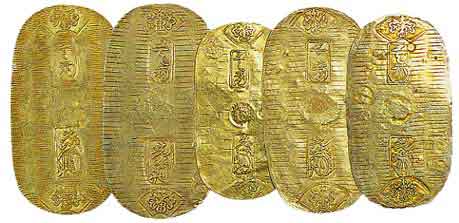 |
||||
| Keicho Koban Weight: approx.17.9g |
Genroku Koban Weight: approx.17.9g |
Hoei Koban Weight: approx.9.4g |
Kyoho Koban Weight: approx.17.9g |
Gembun Koban Weight: approx.13.1g |
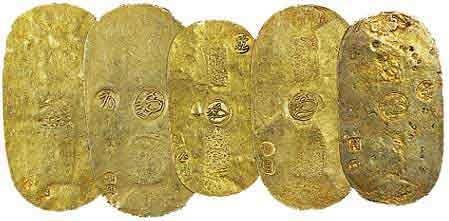 | ||||
A parallel debasement of Japan's silver money took place with the production of coins like the silver Hoei Yotsuho Chogin of 1711 – a coin with a silver content of 20% – Keicho Cho gin and Mameitagin had been minted with a fineness of 80%.
|
|
Hoei Yotsuho Cho-gin, 1711 Silver coins were debased four times in five years beginning with 1706. The poorest-quality cho-gin, with a silver content of merely 20 percent, was called the Hoei Yotsuho Cho-gin. To note the value the Chinese character ho "treasure" within a circle is stamped four times on the coin's face. (Image: curtesy of the Bank of Japan's web page) |
The devaluation of Japan's currency answered the need created by Japan's growing economy with problematic results: Prices of foreign goods rose as Japan's new coins were, of course, no money of a nominal value in the modern sense of the word. There was no central bank offering gold and silver of the promised value for coins circulating under that value. Foreign traders could do what Japanese customers could not do: They could demanded more money to get the amount of fine silver they would get for their goods on other markets. Japanese traders had to fulfil their demands and finally convinced the government in 1710 to issue silver of the original quality to satisfy traders from Korea.
|
|
Oko-gin, 1710 minted to be used by the Tsushima daimyo to pay for imports of Korean ginseng and Chinese raw silk, to satisfy Korea's traders who rejected the Hoei Cho-gin because of its inferior quality. As with other cho-gin (silver coins), an image of the god of wealth and the Chinese character takara, "treasure", are stamped numerous times over the face. The fineness is with 80% comparable to the fineness of the Keicho Cho-gin minted after 1601 – regular cho-gin coins had a silver content of 20-50%. (Image: curtesy of the Bank of Japan's web page) |
The result was a system of double standards. Japan's silver and gold claimed a value it had not – it could do this within the isolated economy. The measure failed, however, on the wider scale. Prices for goods from China and Korea rose after the debasement. To offer the original content of fine silver Japanese merchants had to offer 160% more minted silver after 1695. The debasement of 1706 forced them to offer 200 momme silver where they had offered 100 momme silver of the original quality. The end of the scale were 400 momme matching now the original 100 momme if reduced to fine silver. 400 momme of 20% silver the Japanese trader had bought at home for the price of 80% silver. The problem was not solved with the introduction of expensive 80% silver minted exclusively for the trade with Korea in 1710 nor was it solved with the new silver money issued in 1714 with the old fineness, yet to be bought for a price no one could afford any longer.
The reform came in two steps: To improve the fineness and weight of gold and silver coins the Shotoku Koban was introduced in 1714 – in quality and weight matching the old Keicho Koban. Rumors alleged it was by no means equal in quality to the Keicho Koban. The following year, hence, saw the introduction of the Kyoho Koban, which was slightly higher in quality than the Shotoku Koban and the preceding Keicho Koban had been. The amount of money in circulation dropped with the introduction of the new money. Economic activities came to a standstill, and prices dropped drastically. The measures had consequences down to the rice prices, impoverishing both the samurai class and its farmers.
To stimulate the economy and raise prices, the eighth Tokugawa Shogun, Yoshimune, finally carried out another recoinage in 1736, lowering the quality of gold and silver coins again and increasing their circulation. As had happened with the recoinage of the Genroku and Hoei Koban, the Gembun Koban was debased. Nevertheless, this recoinage deserves more credit, as it supported the Edo period's economic development from the aspect of currency circulation. Governmental profits from the recoinage resolved the problem of a currency shortage, succeeded in turning the economy around, and allowed the currency a high degree of stability for the next 80 years. Japan had taken the step to a currency of nominal values, yet the market brought this currency back to the value given with the coinage itself.
The immediate effects of the recoinage of the 1690s and early 1700s where immensely problematic – Japan suffered a wave of bankruptcies. In the longer perspective the catastrophe led Japan towards even greater autonomy. The economical problem of the trade deficit was not solved by decisions which might have turned Japan into an exporting country able to stabilise its trade balance. Much rather the decisions strengthened the way towards the even severer national seclusion. As for Japan's government the steps taken had their beauty: the clans, beaten in the wars of the 16th century, had made money by issuing paper-money for gold, silver and copper money. In the end the central government had made its own profits in the struggle for power. Profits in money and in power over the money it issued.
A Note on our Conversion Tools
It is at this point everything but uninteresting to offer conversion tools — in order to perform conversions as traders would have performed them and to allow comparisons of prices and wages on the different Asian and European markets exporting and importing goods like silver and porcelain. The rates between gold, silver, and copper coins were fixed by the shogunate government: The 1 Ryo gold coin matched 50 momme of silver or 4 kan of copper coins. Actual rates differed due to the changes of supply of gold and silver on the market and due to different evaluations of the coins involved. The Kenji gold Koban minted in the 16th century had stood at 60 momme of silver, the Keicho gold Koban of 1601 had been changed into 80-90 momme silver, the Genroku gold Koban of 1695 came to be accepted as an equivalent of 70 momme silver (Eijiro Honjo (1940), p.6 pdf).
The central unit of account in Japan and between Japan and its few partners abroad was the momme silver – quite conveniently nothing but a unit of weight. The difficulty is, of course, the devaluation of Japan's silver and the double standard it created between the nominal value of money inside Japan and the "real" value of the coin to bee seen from without. Those who traded with Japan made sure they were not paid with bad silver at the rate Japan's government had forced its citizens to accept. In 1710 Japan began to mint silver coins of the old 80% fineness exclusively for its Korean trade partners. If we base our tools on an exchange of regular Dutch silver coins and equivalent amounts of Japanese silver of 80% fineness the rate will be one of 3 Dutch guilders matching 10 momme: On the Japanese side 10 momme of 80% silver will amount to 30 g fine silver. On the other hand 3 Dutch gulden could be an amount of fine silver between 28.67 and 30.88 g depending on whether one paid in silver gulden (of 10.49 g coin weight and 91.1% fineness) or more valuable Leeuwendaalders (the equivalent of 3 gulden, each coin of 27.53 g metal weight and 74.3% fineness) – with both coins we get a corridor of tolerance our conversion should aim at.
The factor of 3 was chosen to facilitate further computations with silver of less than the nominal 80% fineness. The new coinage could be imposed on a country of closed borders and we get accurate information about the general structure of prices and wages if we allow the new money to have – at least initially – actually circulated at its nominal value. Rates with 80% silver are otherwise misleading. If one changed money one took care of compensations or demanded better coins. If you think of actual money being changed you will hence ask to take the actual fineness of Japanese silver into account. To do so you change the first factor of our conversion tools: 3 stands for 3 g silver and the orginal money of 80 percent fineness, make the momme contain it 1.88 g silver and you will calculate with money minted after 1695s, go down to 0.75 g silver per momme to calculate with the ultimate debasement of 1710. You will now need 133 and a third momme to match 10 Dutch gulden. The price of foreign goods had more than quadruppled, so the perception Japanese customers had, when buying with their new money, a money they had received for a very dear price indeed.link
Literature
- Camfferman, K./ Cooke, T.E., "The Profits of the Dutch East India Company's Japan Trade", Abacus, vol. 40, no. 1, (February 2004), pp. 49-75(27). link
- Sungil, Chung, "The Volume of Early Modern Korea-Japan Trade: A Comparison with the Japan-Holland Trade," Acta Koreana, vol 7-1 (2004).
- Shikano, Yoshiaki, "Currency, wage payment and large fund settlement system in Japan: 1600-1868" (Wages and Currency: Global and Historical Comparisons, Symposium in Amsterdam/Leiden, 24-25 May 2002). Abstract
- Ohnuki, Mari, "Paper Money in Japan 2-2 Hansatsu(I): From Their First Issue to Their Prohibition in the Early 1700s", Short Essays on Monetary History Contained in Monetary and Economic Studies, Research Division 3, Institute for Monetary and Economic Studies, Bank of Japan (ed.), Monetary and Economic Studies, 17.1 (1999). link
- Fujii, Noriko, "Oko-gin Silver Coins for Import of Korean Ginseng – A Two-Tiered Pricing System for Silver Coins", Short Essays on Monetary History Contained in Monetary and Economic Studies, Research Division 3, Institute for Monetary and Economic Studies, Bank of Japan (ed.), Monetary and Economic Studies 16.1, (1998). link
- Ohnuki, Mari, "The Genroku, Hoei, Shotoku, Kyoho, and Gembun Koban", Short Essays on Monetary History Contained in Monetary and Economic Studies, Research Division 3, Institute for Monetary and Economic Studies, Bank of Japan (ed.), Monetary and Economic Studies, 15.2 (1997). link
- Tashiro, Kazui, "Exports of Japan's Silver to China via Korea and Changes in the Tokugawa Monetary System during the Seventeenth and Eighteenth Centuries", in: Dennis O. Flynn and Arturo Giraldez (eds.), Metals and Monies in an Emerging Global Economy (Brookfield, VT: Ashgate, 1997).
- Uyenaka, Shuzo, "The Tong Shin Sa and The Tokugawa Bakufu: An Aspect of Korea-Japan Relations, 1603-1867," East Asian Review, 1 (March 1997), 89-98.
- Mikami, Ryuzo, Edo Bakufu: Hasan e no Michi [Edo Period Government: The Road to Bankruptcy] (NHK Books, 1991) [in Japanese].
- Tashiro, Kazui, "Exports of Gold and Silver During the Early Tokugawa Era, 1600-1750", in: Eddy H.G. Van Cauwenberghe (ed.), Money, Coins and Commerce: Essays in the Monetary History of Asia and Europe (From Antiquity to Modern Times): Proceedings of th 4th and 5th International Monetary History Conferences (Leuven, Belgium: Leuven University Press, 1991).
- Tashiro, Kazui, Tokugawa Jidai no Boeki [Trade during Tokugawa Rule] Nihon Keizai Shi (History of the Japanese Economy), vol. 1 (Iwanami Shoten, 1988) [in Japanese].
- Hisamitsu, Juhei, Nihon Kahei Monogatari [The Story of Japanese Coins] (Mainichi Shimbunsha, 1976) [in Japanese].
- Tashiro, Kazui, "Tsushima han's Korean Trade, 1684-1710," Acta Asiatica, 30 (1976), 85-105.
- Bank of Japan, Economic Research Department, ed. Zuroku Nihon no Kahei [Japanese Coins], vol. 3, (Toyo Keizai Shimposha, 1974) [in Japanese].
- Taya, Hirokichi, Kinsei Ginza no Kenkyu (Yoshikawa Kobunkan, 1963). [A study of early modern silver mints in Japanese]
- Honjo, Eijiro, "The Ecomonmic thought in the midde period of the Tokugawa period", Kyoto University Econmonic Review, vol. xv, no. 2 (Kyoto, April 1940), p.1-33. [On monetary politics, price developments and the relatinonship between coinage and price developments, 1688-1763] pdf
- Honjo, Eijiro, "The Ecomonmic thought in the eraly period of the Tokugawa period", Kyoto University Econmonic Review, vol. xiv, no. 4 (Kyoto, Oct. 1938), p.1-17. [Concentrating on the period 1600-1688] pdf
- Honjo, Eijiro, "The Ecomonmic thought in Tokugawa days", Kyoto University Econmonic Review, vol. xiii, no. 1 (Kyoto, Oct. 1938), p.1-22. [Overview of th perod 1600 to 1867] pdf
Subpage of the Marteau Platform of Research in Economic History
